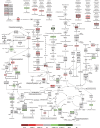Robust Expansion of Human Pluripotent Stem Cells: Integration of Bioprocess Design With Transcriptomic and Metabolomic Characterization
- PMID: 25979863
- PMCID: PMC4479622
- DOI: 10.5966/sctm.2014-0270
Robust Expansion of Human Pluripotent Stem Cells: Integration of Bioprocess Design With Transcriptomic and Metabolomic Characterization
Abstract
: Human embryonic stem cells (hESCs) have an enormous potential as a source for cell replacement therapies, tissue engineering, and in vitro toxicology applications. The lack of standardized and robust bioprocesses for hESC expansion has hindered the application of hESCs and their derivatives in clinical settings. We developed a robust and well-characterized bioprocess for hESC expansion under fully defined conditions and explored the potential of transcriptomic and metabolomic tools for a more comprehensive assessment of culture system impact on cell proliferation, metabolism, and phenotype. Two different hESC lines (feeder-dependent and feeder-free lines) were efficiently expanded on xeno-free microcarriers in stirred culture systems. Both hESC lines maintained the expression of stemness markers such as Oct-4, Nanog, SSEA-4, and TRA1-60 and the ability to spontaneously differentiate into the three germ layers. Whole-genome transcriptome profiling revealed a phenotypic convergence between both hESC lines along the expansion process in stirred-tank bioreactor cultures, providing strong evidence of the robustness of the cultivation process to homogenize cellular phenotype. Under low-oxygen tension, results showed metabolic rearrangement with upregulation of the glycolytic machinery favoring an anaerobic glycolysis Warburg-effect-like phenotype, with no evidence of hypoxic stress response, in contrast to two-dimensional culture. Overall, we report a standardized expansion bioprocess that can guarantee maximal product quality. Furthermore, the "omics" tools used provided relevant findings on the physiological and metabolic changes during hESC expansion in environmentally controlled stirred-tank bioreactors, which can contribute to improved scale-up production systems.
Significance: The clinical application of human pluripotent stem cells (hPSCs) has been hindered by the lack of robust protocols able to sustain production of high cell numbers, as required for regenerative medicine. In this study, a strategy was developed for the expansion of human embryonic stem cells in well-defined culture conditions using microcarrier technology and stirred-tank bioreactors. The use of transcriptomic and metabolic tools allowed detailed characterization of the cell-based product and showed a phenotypic convergence between both hESC lines along the expansion process. This study provided valuable insights into the metabolic hallmarks of hPSC expansion and new information to guide bioprocess design and media optimization for the production of cells with higher quantity and improved quality, which are requisite for translation to the clinic.
Keywords: Human pluripotent stem cells; Metabolic profiling; Stirred-tank bioreactors; Transcriptional profiling; Xeno-free microcarriers.
©AlphaMed Press.
Figures






Similar articles
-
Impact of Feeding Strategies on the Scalable Expansion of Human Pluripotent Stem Cells in Single-Use Stirred Tank Bioreactors.Stem Cells Transl Med. 2016 Oct;5(10):1289-1301. doi: 10.5966/sctm.2015-0253. Epub 2016 Jul 1. Stem Cells Transl Med. 2016. PMID: 27369897 Free PMC article.
-
Facile engineering of xeno-free microcarriers for the scalable cultivation of human pluripotent stem cells in stirred suspension.Tissue Eng Part A. 2014 Feb;20(3-4):588-99. doi: 10.1089/ten.TEA.2013.0219. Epub 2013 Nov 28. Tissue Eng Part A. 2014. PMID: 24098972 Free PMC article.
-
A xenogeneic-free bioreactor system for the clinical-scale expansion of human mesenchymal stem/stromal cells.Biotechnol Bioeng. 2014 Jun;111(6):1116-27. doi: 10.1002/bit.25187. Epub 2014 Feb 4. Biotechnol Bioeng. 2014. PMID: 24420557
-
Microcarrier-based platforms for in vitro expansion and differentiation of human pluripotent stem cells in bioreactor culture systems.J Biotechnol. 2016 Sep 20;234:71-82. doi: 10.1016/j.jbiotec.2016.07.023. Epub 2016 Jul 29. J Biotechnol. 2016. PMID: 27480342 Review.
-
Human embryonic stem cell cultivation: historical perspective and evolution of xeno-free culture systems.Reprod Biol Endocrinol. 2015 Feb 22;13:9. doi: 10.1186/s12958-015-0005-4. Reprod Biol Endocrinol. 2015. PMID: 25890180 Free PMC article. Review.
Cited by
-
Cell-Based Therapy Manufacturing in Stirred Suspension Bioreactor: Thoughts for cGMP Compliance.Front Bioeng Biotechnol. 2020 Nov 26;8:599674. doi: 10.3389/fbioe.2020.599674. eCollection 2020. Front Bioeng Biotechnol. 2020. PMID: 33324625 Free PMC article. Review.
-
In situ transcriptome characteristics are lost following culture adaptation of adult cardiac stem cells.Sci Rep. 2018 Aug 13;8(1):12060. doi: 10.1038/s41598-018-30551-1. Sci Rep. 2018. PMID: 30104715 Free PMC article.
-
Impact of Feeding Strategies on the Scalable Expansion of Human Pluripotent Stem Cells in Single-Use Stirred Tank Bioreactors.Stem Cells Transl Med. 2016 Oct;5(10):1289-1301. doi: 10.5966/sctm.2015-0253. Epub 2016 Jul 1. Stem Cells Transl Med. 2016. PMID: 27369897 Free PMC article.
-
Expansion Culture of Human Pluripotent Stem Cells and Production of Cardiomyocytes.Bioengineering (Basel). 2019 May 24;6(2):48. doi: 10.3390/bioengineering6020048. Bioengineering (Basel). 2019. PMID: 31137703 Free PMC article. Review.
-
Common pitfalls of stem cell differentiation: a guide to improving protocols for neurodegenerative disease models and research.Cell Mol Life Sci. 2016 Oct;73(19):3693-709. doi: 10.1007/s00018-016-2265-3. Epub 2016 May 6. Cell Mol Life Sci. 2016. PMID: 27154043 Free PMC article. Review.
References
LinkOut - more resources
Full Text Sources
Other Literature Sources
Molecular Biology Databases
Research Materials
Miscellaneous

